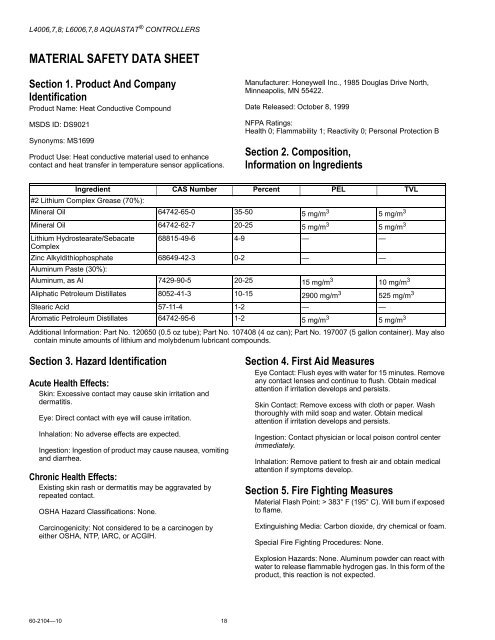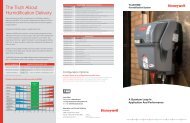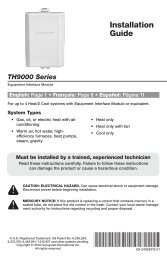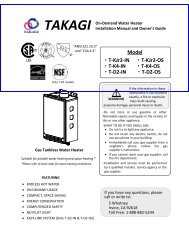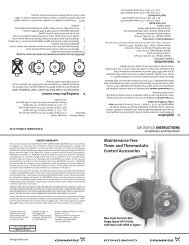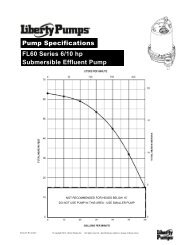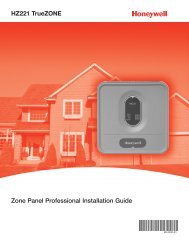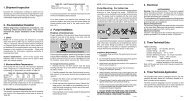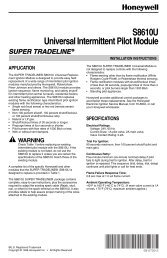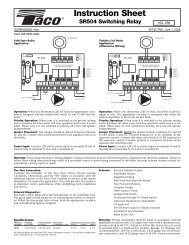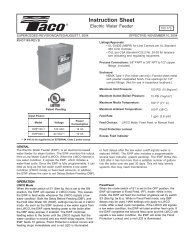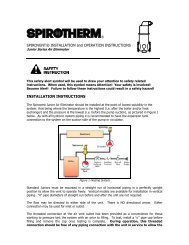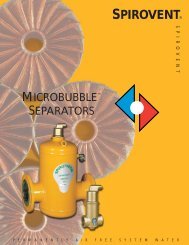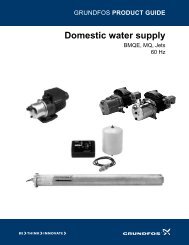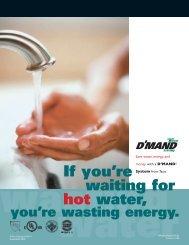60-2104-10 - L4006,7,8; L6006,7,8 Aquastat ... - PexSupply.com
60-2104-10 - L4006,7,8; L6006,7,8 Aquastat ... - PexSupply.com
60-2104-10 - L4006,7,8; L6006,7,8 Aquastat ... - PexSupply.com
You also want an ePaper? Increase the reach of your titles
YUMPU automatically turns print PDFs into web optimized ePapers that Google loves.
<strong>L4006</strong>,7,8; L<strong>60</strong>06,7,8 AQUASTAT ® CONTROLLERS<br />
MATERIAL SAFETY DATA SHEET<br />
Section 1. Product And Company<br />
Identification<br />
Product Name: Heat Conductive Compound<br />
MSDS ID: DS9021<br />
Synonyms: MS1699<br />
Product Use: Heat conductive material used to enhance<br />
contact and heat transfer in temperature sensor applications.<br />
Manufacturer: Honeywell Inc., 1985 Douglas Drive North,<br />
Minneapolis, MN 55422.<br />
Date Released: October 8, 1999<br />
NFPA Ratings:<br />
Health 0; Flammability 1; Reactivity 0; Personal Protection B<br />
Section 2. Composition,<br />
Information on Ingredients<br />
Ingredient CAS Number Percent PEL TVL<br />
#2 Lithium Complex Grease (70%):<br />
Mineral Oil 64742-65-0 35-50 5 mg/m 3 5 mg/m 3<br />
Mineral Oil 64742-62-7 20-25 5 mg/m 3 5 mg/m 3<br />
Lithium Hydrostearate/Sebacate 68815-49-6 4-9 — —<br />
Complex<br />
Zinc Alkyldithiophosphate 68649-42-3 0-2 — —<br />
Aluminum Paste (30%):<br />
Aluminum, as Al 7429-90-5 20-25 15 mg/m 3 <strong>10</strong> mg/m 3<br />
Aliphatic Petroleum Distillates 8052-41-3 <strong>10</strong>-15 2900 mg/m 3 525 mg/m 3<br />
Stearic Acid 57-11-4 1-2 — —<br />
Aromatic Petroleum Distillates 64742-95-6 1-2 5 mg/m 3 5 mg/m 3<br />
Additional Information: Part No. 120650 (0.5 oz tube); Part No. <strong>10</strong>7408 (4 oz can); Part No. 197007 (5 gallon container). May also<br />
contain minute amounts of lithium and molybdenum lubricant <strong>com</strong>pounds.<br />
Section 3. Hazard Identification<br />
Acute Health Effects:<br />
Skin: Excessive contact may cause skin irritation and<br />
dermatitis.<br />
Eye: Direct contact with eye will cause irritation.<br />
Inhalation: No adverse effects are expected.<br />
Ingestion: Ingestion of product may cause nausea, vomiting<br />
and diarrhea.<br />
Chronic Health Effects:<br />
Existing skin rash or dermatitis may be aggravated by<br />
repeated contact.<br />
OSHA Hazard Classifications: None.<br />
Carcinogenicity: Not considered to be a carcinogen by<br />
either OSHA, NTP, IARC, or ACGIH.<br />
Section 4. First Aid Measures<br />
Eye Contact: Flush eyes with water for 15 minutes. Remove<br />
any contact lenses and continue to flush. Obtain medical<br />
attention if irritation develops and persists.<br />
Skin Contact: Remove excess with cloth or paper. Wash<br />
thoroughly with mild soap and water. Obtain medical<br />
attention if irritation develops and persists.<br />
Ingestion: Contact physician or local poison control center<br />
immediately.<br />
Inhalation: Remove patient to fresh air and obtain medical<br />
attention if symptoms develop.<br />
Section 5. Fire Fighting Measures<br />
Material Flash Point: > 383° F (195° C). Will burn if exposed<br />
to flame.<br />
Extinguishing Media: Carbon dioxide, dry chemical or foam.<br />
Special Fire Fighting Procedures: None.<br />
Explosion Hazards: None. Aluminum powder can react with<br />
water to release flammable hydrogen gas. In this form of the<br />
product, this reaction is not expected.<br />
<strong>60</strong>-<strong>2<strong>10</strong>4</strong>—<strong>10</strong> 18


